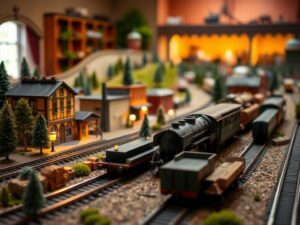How to Keep Your HO Scale Trains Running Smoothly
How to Keep Your HO Scale Trains Running Smoothly
How to Keep Your HO Scale Trains Running Smoothly
Welcome aboard! Whether you’re a fresh-faced enthusiast just starting your first layout or a seasoned operator looking to tweak your trains’ performance, this blog post is dedicated to helping you keep those HO scale trains rolling like clockwork. Remember, smooth operation isn’t just about aesthetics â it’s the key to truly immersive model railroading experiences!
Let’s break down the essential aspects of HO scale train maintenance, offering tips and tricks that work for beginners and advanced hobbyists alike.
1. The ABCs of Wheel Condition:
A trainâs wheels are its lifeline â literally! They’re the point of contact between your locomotives and rolling stock and the track. Here’s what you need to know:
-
Wheel Cleaning:
- Accumulated dirt, debris, and oxidation can create resistance, leading to sluggishness and potential derailments. A good practice is to clean your wheels regularly.
- Use a soft brush or a commercially available track cleaner solution. Gently scrub each wheelset, focusing on the contact points where the wheels meet the rails.
-
Lubrication: While less frequent than cleaning, proper lubrication plays a vital role. Dry wheels create friction, generating heat and wear.
- Apply a small amount of lubricant specifically designed for model trains (avoid mineral oil â it can gum up).
- A toothpick or thin brush is ideal for applying lubricant to wheel flanges and axles. Remember: a little goes a long way!
2. Power Pickups: Your Locomotive’s Fuel Lines:
Locomotives use electrical “power pickups” (contacts) that connect with the rails, delivering energy to their motors. Ensuring these are clean and properly aligned is crucial.
-
Inspection: Examine your locomotives’ pickup shoes or contact strips for wear, debris, or bending. A dull or heavily soiled pick up will hamper performance.
-
Cleaning: Use a cotton swab dampened with rubbing alcohol or a dedicated cleaner to gently wipe the pickups.
- Avoid scratching sensitive components. After cleaning, allow them to dry thoroughly.
3. Track Inspection and Cleaning: A Smooth Journey for Everyone:
Track problems can manifest in many ways â from sluggish train movement to derailments. Investing time in track inspection is well worth it.
- Gauging: Use a gauge to ensure your rails maintain the correct HO scale (1:87) distance between them. Any widening or narrowing can cause binding and derailments.
-
Straightening: A simple track aligner tool can quickly address any small bends or curves that might be disrupting your trainâs path.
-
Dirt Removal: Even a few tiny particles on the rails can impede electrical conductivity, slowing your trains down. Use a brush designed for cleaning track surfaces to remove dust and debris regularly.
4. Essential Tools Every Model Railroader Needs:
No model railroad setup is complete without a toolkit filled with handy gadgets:
- Small Phillips and Flathead Screwdrivers: For fine adjustments and accessing intricate parts within your locomotives and rolling stock.
- Track Gauge: Ensure proper track alignment for smooth train travel.
- Wire Strippers/Cutters: Ideal for working with wiring and adding detail features to your layout.
- Superglue and Small Tweezers: For quick repairs and handling delicate components.
5. Understanding Electronics:
While not everyone is a seasoned electronics whiz, a basic understanding can go a long way in troubleshooting issues:
- Voltage Regulator (If Used): This component regulates the voltage delivered to your trains. Ensure it’s functioning correctly as voltage fluctuations can cause motor strain and performance issues.
- Circuit Breaker: These safeguard against overloads and shorts. Familiarize yourself with resetting the circuit breaker if tripped â this prevents further damage to your layoutâs electronics.
6. The Power of Observation:
Develop a keen eye for your trains’ movements and listen attentively for any unusual sounds. Early detection can prevent larger problems from developing:
- Stalling: Does your train come to sudden stops or hesitate when traversing curves? This might indicate wheel cleaning needs or a dirty track section.
- Humming: An unusually loud hum from the motor could suggest overheating, indicating lubrication is needed or that the motor may be failing.
7. Patience and Persistence:
Mastering model railroad maintenance takes time and practice. Don’t get discouraged if you encounter issues â remember to stay calm, analyze the problem carefully, and refer to your manual or online resources for solutions. Thereâs a vast community of dedicated hobbyists willing to offer help and guidance!
Concluding Thoughts:
Taking care of your HO scale trains goes beyond just aesthetics â it’s about ensuring a smooth, enjoyable experience every time you step onto your layout. Remember, preventative maintenance is key! By incorporating these tips into your routine, you can prolong the lifespan of your trains, keep them running smoothly, and unlock the true joy of model railroading.
Have fun experimenting, troubleshooting, and creating intricate, awe-inspiring landscapes with your HO scale masterpieces. Let me know in the comments if you have any specific questions â I’m always eager to connect with fellow hobbyists and share my passion for this incredible world!




